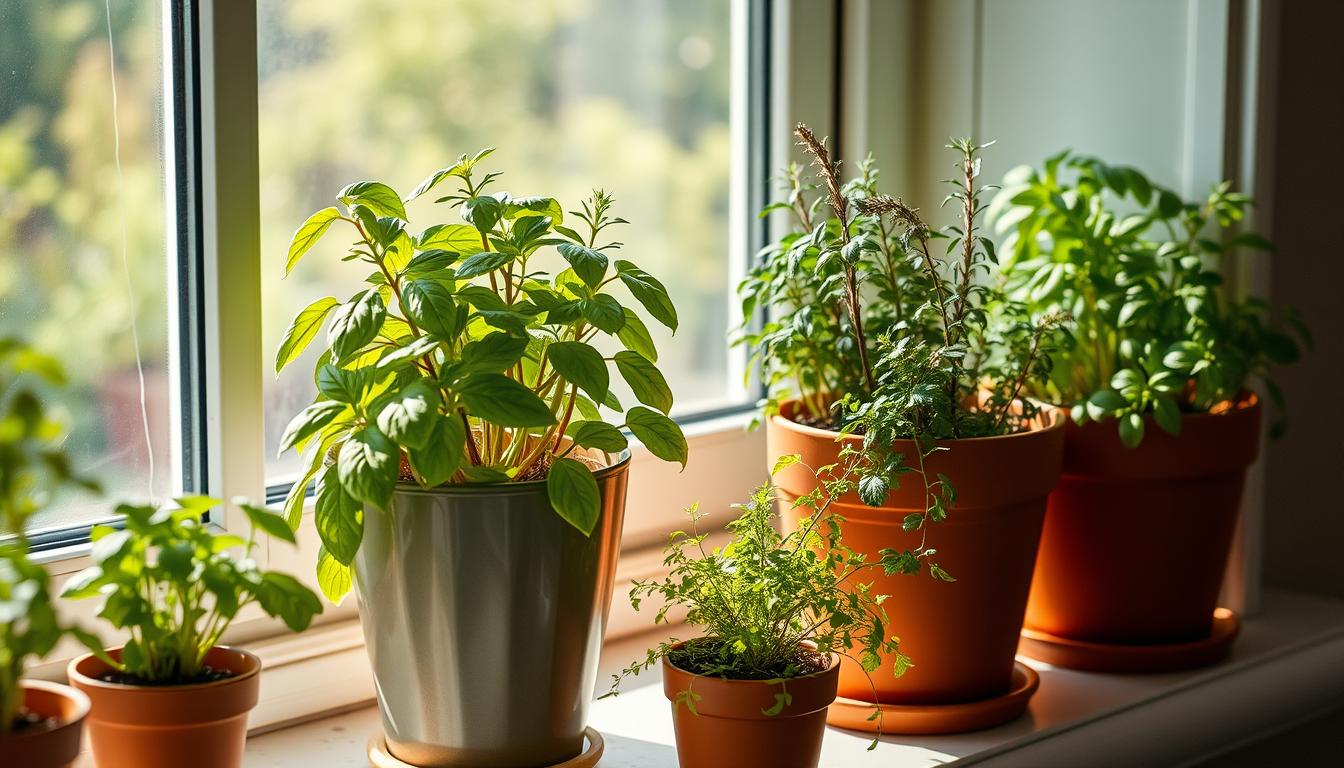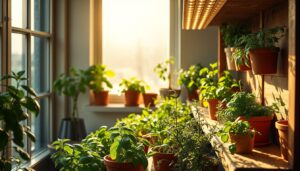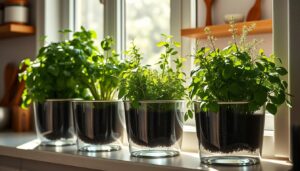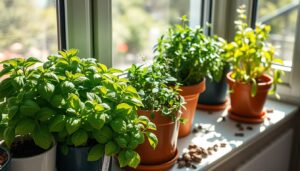Did you know over 60% of American households now grow herbs indoors or outdoors? This shows how popular homegrown culinary herbs have become. They offer fresh, flavorful ingredients all year. By growing herbs at home, you get a steady supply of fragrant leaves for your dishes. This is without the limits of outdoor growing seasons.
Key Takeaways
- Grow a variety of herbs indoors year-round for a constant supply of fresh, flavorful leaves
- Enjoy the convenience of having herbs at your fingertips, ready to add to your favorite recipes
- Discover herbs that thrive in low-light conditions, such as mint, lemon balm, and tarragon
- Explore the decorative appeal of an indoor herb garden, adding greenery and fragrance to your living space
- Learn the requirements for successful indoor herb gardening, including lighting, temperature, and soil needs
Introduction to Growing Herbs Indoors
Imagine having fresh, aromatic herbs right at your fingertips. Growing herbs indoors is a great way to have them all year. It lets you enjoy the flavors and benefits of these plants anytime.
The Convenience of Fresh Herbs at Your Fingertips
With an indoor herb garden, you can easily grab herbs like chives, parsley, or mint for your dishes. No need to go to the backyard or the store. Your kitchen herbs are always close by, ready to make your meals taste better.
Year-Round Availability of Flavorful Culinary Ingredients
Growing herbs indoors means you can enjoy their flavors all year, even when it’s cold outside. You can keep a steady supply of windowsill herbs for your cooking. This way, you always have year-round fresh herbs for your kitchen.
“Having fresh herbs at my fingertips has completely transformed the way I cook. My dishes are now infused with vibrant flavors that simply can’t be replicated with dried herbs.”
– Sarah, Avid Home Cook
Herbs that Thrive Indoors Year-Round
Not all herbs are the same when it comes to indoor growing. But, some herbs that thrive indoors year-round are perfect for adding flavor to your cooking. Chives, with their mild taste, and winter savory, which loves cool temperatures, are great for indoor gardens. Horehound, known for its slightly bitter flavor, is also a low-light herb that’s great for cooking.
Chives, Winter Savory, and Horehound
Chives are easy to grow indoors and add a fresh taste to dishes. Winter savory does well in cooler temperatures, making it perfect for indoor gardens all year. Horehound, with its unique flavor, is another low-light herb that can spice up your meals.
Mint, Lemon Balm, and Tarragon for Low-Light Conditions
If you have little sunlight, mint, lemon balm, and tarragon are great choices. Mint is known for its refreshing taste and can grow well in low light. Lemon balm and tarragon, with their unique flavors, are also great for low-light herbs in your indoor garden.
Adding these year-round indoor herbs to your home means you always have fresh ingredients on hand. Whether you’re an experienced gardener or just starting, these herbs are easy to care for. They’ll bring a bit of nature indoors for you to enjoy.
Requirements for Successful Indoor Herb Gardening
To grow a successful indoor herb garden, you need to consider a few key things. First, make sure your herbs get enough sunlight. Most herbs need 6 hours of direct sunlight each day.
Place them near a south-facing window or use grow lights to help. This is crucial for their growth.
Adequate Sunlight and Lighting Options
Next, keep the right temperature and humidity for your herbs. The best daytime temperature is between 65-70°F. At night, it should be 55-60°F.
Also, keep the humidity between 40-60%. This helps your herbs grow strong.
Proper Temperature and Humidity Levels
The type of soil and containers you use are also important. Use soil that drains well or a mix made for indoor plants. Make sure your containers have holes for drainage to prevent water from pooling.
By following these tips, your indoor herb gardening will do great. You’ll get a lot of fresh herbs to use in your cooking.
Well-Draining Soil and Containers with Drainage Holes
| Requirement | Optimal Conditions |
|---|---|
| Sunlight | 6+ hours of direct sunlight per day |
| Temperature | 65-70°F (day), 55-60°F (night) |
| Humidity | 40-60% |
| Potting Medium | Well-draining soil or indoor potting mix |
| Container | Containers with drainage holes |
“By meeting these environmental needs, your indoor herb gardening endeavors are sure to thrive and provide a plentiful harvest.”
Indoor Herb Garden Setup and Maintenance
Creating a container herb garden or indoor herb garden at home needs some thought. You must pick the right potting mix and set up a watering and fertilizing plan. These steps will help you grow herbs at home and have fresh, tasty herbs all year.
Potting Mixes and Container Choices
For your indoor herb garden, choose a potting mix that drains well and is full of nutrients. Adding compost or perlite to the mix helps keep the soil moist but also lets air in. Pick containers that are deep and wide for your herbs. They should have lots of drainage holes to stop water from pooling.
Watering and Fertilizing Regimens
It’s important to water your container herb garden regularly. Check the soil often and water when it feels dry. Don’t water too much. Feed your herbs with a weak, water-soluble fertilizer every two weeks. This gives them the vitamins and minerals they need without making them taste bad.
| Potting Mix Recommendations | Ideal Container Sizes |
|---|---|
| Organic, well-draining mix with compost or perlite | 6-8 inches deep, 8-12 inches wide |
By focusing on these key parts of indoor herb gardening, you can make a container herb garden that’s easy to take care of. It will give you a lot of fresh herbs all year.
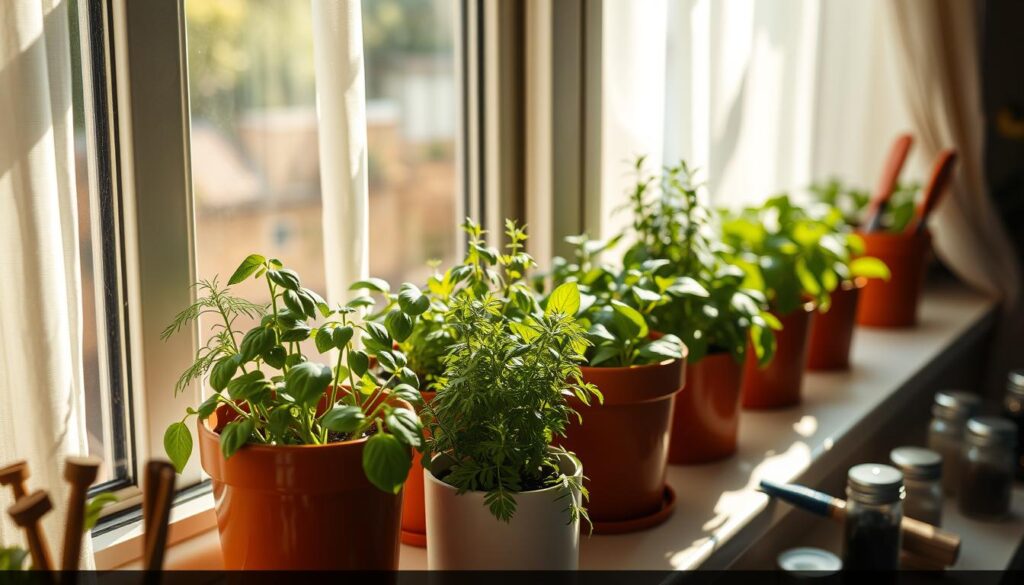
Pest and Disease Management for Indoor Herbs
Growing indoor herbs can be rewarding but also challenging. Keeping your houseplant herbs healthy means managing pests and diseases. With the right strategies, you can keep your indoor herb garden thriving all year.
Aphids are a common problem for indoor herb growers. These tiny insects can harm your plants by sucking their sap. To fight aphids, use a mild soap solution or a gentle horticultural oil spray. Make sure to wash the herbs well before using them. Good air circulation and humidity levels can also keep aphids away.
Spider mites are another issue, especially in dry, warm places. These tiny arachnids build webs and eat the leaves of your herbs. To stop spider mites, try neem oil-based insecticides or a mix of water and vinegar.
- Regularly check your indoor herbs for pests like discolored leaves or webs
- Use organic methods like insecticidal soaps or horticultural oils to fight pests
- Keep humidity and air circulation right to make pests less likely to show up
Indoor herbs can also get fungal diseases like powdery mildew. This disease looks like a white powder and can spread fast. To fight it, make sure your herbs have good air flow and don’t crowd them. You can also use baking soda or milk to help stop powdery mildew.
| Common Indoor Herb Pests | Effective Management Strategies |
|---|---|
| Aphids | Mild soap solution, horticultural oil, maintaining air circulation |
| Spider Mites | Neem oil-based insecticide, water and vinegar solution |
| Powdery Mildew | Improving air circulation, baking soda or milk-based solution |
By being vigilant and using eco-friendly methods, you can keep your indoor herb garden healthy. This way, you’ll have a steady supply of fresh, tasty herbs all year.
Transitioning Indoor Herbs Outdoors During Warmer Months
As warmer months come, you might want to move your indoor herb garden outside. This lets them get natural sunlight and grow more. But, you need to slowly get them used to the outdoors to make sure they do well.
Acclimating Herbs to Outdoor Conditions
Start by slowly showing your indoor herbs more sunlight over a few days. Put them in the shade at first and then move them into more sunlight. This helps them get used to the strong sunlight without getting hurt.
Increasing Watering and Fertilizing Needs
When you move your herbs outside, they’ll need more water and food. The outdoors makes plants dry out faster and they grow faster. So, you’ll need to water and feed them more often to keep them healthy.
By moving your indoor herbs outside carefully, they can keep growing well and give you lots of fresh herbs. With the right steps and changes in care, your indoor herb gardening can easily move to grow herbs at home outside.
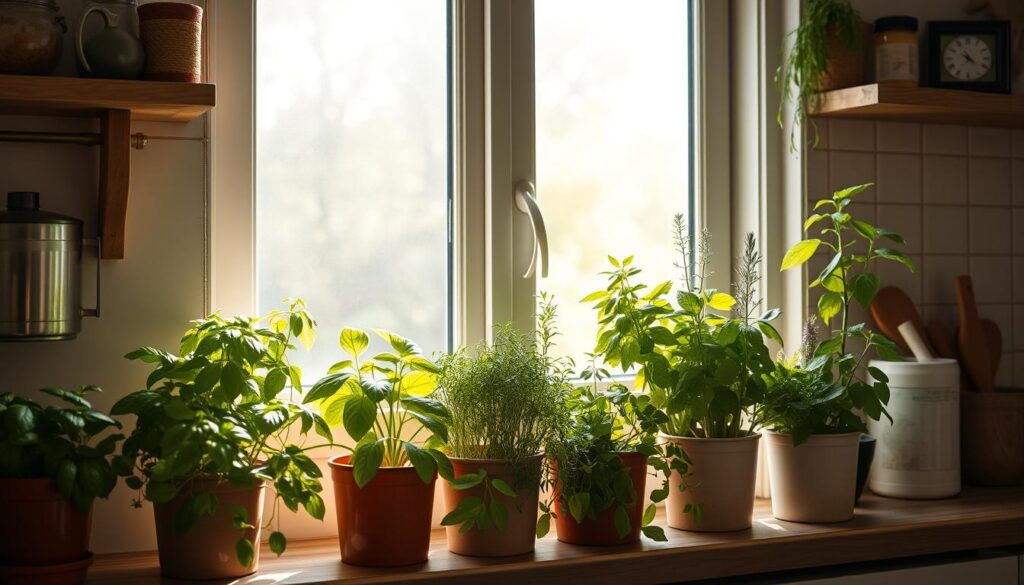
Culinary Delights with Fresh Indoor Herbs
Having a indoor herb garden makes it easy to add fresh, flavorful herbs to your cooking. You can sprinkle chives on scrambled eggs, add oregano to pasta sauce, or use mint in your tea. Homegrown herbs can make any dish or drink taste better.
Adding Flavor and Aroma to Dishes
Fresh indoor herbs have a stronger taste than dried ones. This means you can use less and still get a big flavor boost. A little rosemary can make roasted chicken taste amazing. Adding thyme to a stew can deepen its flavor. Culinary herbs indoors also make your meals look and smell great.
Herbal Teas and Beverages
- Steep a refreshing cup of lemon balm tea for a soothing and calming experience.
- Muddle mint leaves with ice, lime, and a touch of honey for a rejuvenating summer mocktail.
- Enhance your year-round fresh herbs by infusing them into homemade syrups, vinegars, or even cocktails.
Kitchen herbs grown indoors open up new possibilities in the kitchen. They add amazing flavors and smells to your food and drinks. Just adding these plants can take your cooking to the next level.
Decorative Appeal of Indoor Herb Gardens
Indoor herb gardening is more than just growing houseplant herbs for cooking. It also makes your home look great. By placing potted herbs on a sunny windowsill or as a centerpiece, you add charm and style. This makes your home’s décor even better.
Herbs like chives, winter savory, and horehound have unique shapes and colors. Mint, lemon balm, and tarragon do well in low light, perfect for indoor gardens.
An indoor herb garden looks great in hanging baskets, window boxes, or decorative pots. It brings greenery and smells that make your home feel more natural and full of life. Plus, it’s a great place to get fresh herbs for cooking.
“An indoor herb garden is not only a practical source of fresh, flavorful ingredients, but it can also be a visually stunning feature that enhances the ambiance of your home.”
Think about adding an indoor herb gardening to your home. With some creativity and care, you get to enjoy the taste and beauty of these houseplant herbs. They add flavor and style to your space.
Herbs that Thrive Indoors Year-Round
If you’re a home cook who loves fresh herbs, you’ll find many that can grow indoors all year. Not every herb does well inside, but some are perfect for indoor gardens. They are hardy, easy to care for, and give you fresh flavors all the time.
Chives, winter savory, and horehound are great for indoor gardens. They handle low light, changing temperatures, and humidity well. Mint, lemon balm, and tarragon also do well in places with little sunlight.
- Chives: A versatile herb that can add a subtle onion-like flavor to a variety of dishes.
- Winter Savory: Offers a peppery, slightly minty taste, making it a great addition to soups, stews, and roasted meats.
- Horehound: Known for its unique, slightly bitter flavor, horehound is often used in cough drops and herbal teas.
- Mint: Thrives in low-light conditions and adds a refreshing, aromatic touch to beverages, desserts, and more.
- Lemon Balm: Boasts a bright, lemony flavor that can enhance both sweet and savory dishes.
- Tarragon: Adds a subtle licorice-like flavor to chicken, fish, and egg dishes.
Adding these hardy herbs to your indoor garden means you can have fresh, homegrown ingredients all year. It’s convenient and adds flavor to your cooking.
Space-Saving Solutions for Indoor Herb Gardening
Growing herbs indoors is a great way to have fresh, tasty ingredients all year. Even in small homes, there are many smart ways to make an indoor herb garden. These solutions let you grow herbs without using up too much space.
Window Boxes and Hanging Baskets
Think about using window boxes or hanging baskets for a vertical herb garden. These containers are perfect for herbs and make your indoor space look nice. You can grow herbs like basil, oregano, rosemary, and thyme in them.
Compact Varieties for Small Spaces
Choosing the right herbs is key for indoor gardening. Look for container herb garden or grow herbs at home options that don’t grow too big. Dwarf or miniature herbs are great for small pots or hanging baskets.
With these smart ideas, you can have fresh herbs even in a small place. A little creativity and the right plants can turn your home into a beautiful indoor herb gardening spot.
Conclusion
Growing herbs indoors year-round is a rewarding and practical hobby. It’s perfect for cooks who love fresh, flavorful ingredients or nature lovers who want indoor greenery. By learning what herbs need in low light, you can have a garden full of plants all year.
Having fresh herbs anytime is a big plus. Plus, an indoor herb garden looks great. By following the best gardening tips, your plants will do well and last longer. This means you can enjoy the taste and smell of your own herbs.
With the right knowledge and effort, your home can become a lush oasis of herbs. This adds flavor to your cooking and makes your home look beautiful. Let your love for indoor gardening grow into a lifelong hobby of tasty and eco-friendly living.
FAQ
What are the benefits of growing herbs indoors year-round?
What types of herbs can be grown successfully indoors?
What are the key requirements for successful indoor herb gardening?
How do you set up and maintain an indoor herb garden?
How do you deal with pests and diseases in an indoor herb garden?
How do you transition indoor herbs to the outdoors during the warmer months?
How can fresh indoor herbs enhance your cooking and beverages?
How can indoor herb gardens enhance the decor of your home?
What are some space-saving solutions for growing herbs indoors?
Source Links
- Growing Herbs Indoors – https://extension.psu.edu/growing-herbs-indoors
- Growing Herbs as Houseplants – https://fifthseasongardening.com/growing-herbs-as-houseplants
- The Dos and Don’ts of Growing Herbs Inside – Fine Gardening – https://www.finegardening.com/project-guides/fruits-and-vegetables/the-dos-and-donts-of-growing-herbs-indoors


